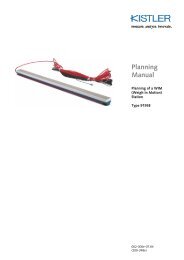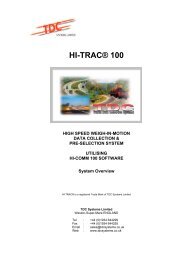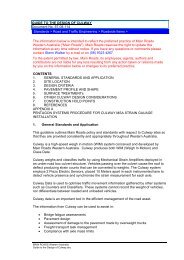Culway WIM Calibration Drift and Normalisation_DTEI
Culway WIM Calibration Drift and Normalisation_DTEI
Culway WIM Calibration Drift and Normalisation_DTEI
You also want an ePaper? Increase the reach of your titles
YUMPU automatically turns print PDFs into web optimized ePapers that Google loves.
Introduction<br />
Since the late 1990’s the topic of ‘calibration drift’ has been the subject of various discussions <strong>and</strong><br />
written papers. In particular Mr. R.J.Peters (Main Roads WA) has explored <strong>and</strong> written papers on<br />
calibration drift <strong>and</strong> I am hoping that my research <strong>and</strong> findings will add value to this topic.<br />
I have worked with the <strong>Culway</strong> <strong>WIM</strong> system since 1994 <strong>and</strong> by 1996 I had formed the opinion that<br />
calibration drift existed to some degree or another at all our <strong>Culway</strong> sites. Over the years we have had<br />
to address various problems <strong>and</strong> issues relating to the continuous improvement of our <strong>Culway</strong> sites.<br />
One of the key issues has always been calibration drift - what causes it, <strong>and</strong> what can we do to<br />
compensate for it?<br />
Methodology<br />
By 1997 I was convinced that most of the effects of calibration drift resulted from temperature<br />
variations in the road surface/pavement. <strong>Calibration</strong> drift can also be influenced by other<br />
environmental factors (eg. moisture, wind <strong>and</strong> cloud cover). However, I believe that at the end of the<br />
day it doesn’t matter what causes it, as long as you can recognise when it is happening <strong>and</strong> you have<br />
an effective way of dealing with it <strong>and</strong>/or compensating for it. At the time I did not have a lot of<br />
evidence to support this theory but I still proceeded with developing a method to compensate for what<br />
ever was causing the drift in calibration.<br />
The method I use is based on the average steer axle weights for class 9 vehicles (Type A123 only). As<br />
highlighted by Mr. R.J.Peters the steer weights of type A123 vehicles do not vary much (regardless of<br />
the loading condition). Hence, I firstly calculate the average A123 steer axle weight for each of our<br />
<strong>Culway</strong> sites from data collected during calibration exercises <strong>and</strong> vehicle weighing stations (the<br />
average varies slightly from site to site between 5.5 <strong>and</strong> 5.8 tonnes). These were then used as<br />
benchmark weights for monitoring <strong>and</strong> subsequently ‘normalising’ our <strong>Culway</strong> <strong>WIM</strong> data. I then used<br />
spreadsheets to determine where sensitivity factors (CF1) needed to be adjusted to compensate for<br />
calibration drift. We have now been using this method of ‘normalising’ our <strong>Culway</strong> <strong>WIM</strong> data for the<br />
past 9 years during which time my colleague Roger Bloor has improved the process, by creating new<br />
spreadsheets with additional formulas <strong>and</strong> macros.<br />
The only time that I have experienced calibration drift at a <strong>Culway</strong> site due to moisture was when we<br />
had a temporary drainage problem at one of our sites. Road works had altered the drainage at the site<br />
creating a build up of water on the side of the road. This caused the shoulders <strong>and</strong> road pavement<br />
material to become saturated. The problems at this site were immediately apparent from the <strong>Culway</strong><br />
<strong>WIM</strong> data (even before the road surface/pavement began to fail). As soon as the drainage problem was<br />
rectified <strong>and</strong> the road repaired, the site was recalibrated <strong>and</strong> thereafter we did not experience any<br />
significant calibration drift at this site. From this I concluded that as long as the moisture content in the<br />
base <strong>and</strong> sub-base material of the road pavement can be maintained at a reasonably constant level then<br />
moisture will have very little to do with the drift in calibration.<br />
One could argue about which of the environmental factors contributes most to calibration drift, <strong>and</strong><br />
even though I believe that temperature is the main factor, the key question is - what is the influence on<br />
the strain readings (which is what the calibration factors are applied to)?<br />
The answer is not actually in the temperature or moisture (or any of the other environmental factors) it<br />
is in the road surface/pavement. When we talk about ‘calibration drift’ we should actually be focusing<br />
our attention to the ‘stiffness’ or ‘rigidity’ of the road surface <strong>and</strong> pavement. The rigidity of a flexible<br />
road surface/pavement changes with temperature <strong>and</strong> this has a direct impact on the strain readings.<br />
That is why sites that have a deep asphalt surface can change dramatically as the temperature changes.<br />
<strong>Culway</strong> <strong>WIM</strong> <strong>Calibration</strong> <strong>Drift</strong> <strong>and</strong> <strong>Normalisation</strong>.doc Page 2 of 9
















